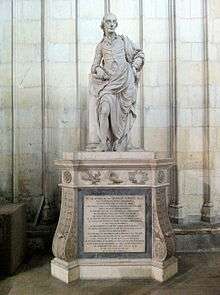Sir George Savile, 8th Baronet

Sir George Savile, 8th Baronet (18 July 1726 – 10 January 1784) was an English politician.
Background
Savile was born in Savile House, London, the only son of Sir George Savile, 7th Baronet and Lady Savile (born Mary Pratt, later married to Charles Morton), of Rufford Abbey, Nottinghamshire and inherited his baronetcy on the death of his father in 1743. Savile was educated at Queens' College, Cambridge.[1]
Political career
He entered the House of Commons as member for Yorkshire in 1759. In general he advocated views of a very liberal character, including measures of relief to Roman Catholics and to Protestant dissenters, and he defended the action of the American colonists. He introduced the Catholic Relief Act, leading to the Gordon Riots in 1780. He refused to take office and in 1783 he resigned his seat in parliament. He was elected a Fellow of the Royal Society in December 1747.[2]
Personal life
Savile died unmarried in London and was buried in the family vault at Thornhill, Yorkshire. Horace Walpole said Savile had a large fortune and a larger mind, and Edmund Burke also had a high opinion of him.
Part of the inscription on his statue in York Minster by John Fisher reads,
"In private life, he was benevolent, and sincere;
His charities were extensive and secret;
His whole heart was founded on principles
Of generosity, mildness, justice, and universal candour.
In public, the patron of every national improvement;
In the senate, incorrupt;
In his commerce with the world, disinterested."
Bequests
Rufford Abbey and some of his other estates were bequeathed to his nephew, Richard Lumley (1757–1832), a younger son of Richard Lumley-Saunderson, 4th Earl of Scarbrough (1725–1752). Richard took the additional name of Savile, but when on his brother's death in 1807 he became 6th Earl of Scarbrough the Savile estates passed to his brother John (1760–1835), afterwards the 7th earl. John's son and heir was John Lumley-Savile, 8th Earl of Scarbrough (1788–1856). The 8th earl was never married, but he left four natural sons, the eldest of whom was John Savile (1818–1896), the diplomatist, who was created Baron Savile of Rufford in 1888. He entered the foreign office in 1841, was British envoy at Dresden and Bern, and from 1883 to 1888 represented his country in Rome. Although the eldest son, he did not inherit Rufford and his father's other estates until after the deaths of two of his younger brothers. He made a fine collection of pictures and died at Rufford on 28 November 1896, when his nephew John Savile Lumley-Savile, 2nd Baron Savile (b. 1854) became the 2nd baron. He was a member of the Oddfellows.[3]
See also
References
- ↑ http://www.queens.cam.ac.uk/page-242
- ↑ "Library and Archive Catalog". The Royal Society. Retrieved 11 October 2010.
- ↑ Ayon kay Victoria Solt Dennis, Discovering Friendly and Fraternal Societies: Their Badges and Regalia, page 90
![]() This article incorporates text from a publication now in the public domain: Chisholm, Hugh, ed. (1911). "article name needed". Encyclopædia Britannica (11th ed.). Cambridge University Press.
This article incorporates text from a publication now in the public domain: Chisholm, Hugh, ed. (1911). "article name needed". Encyclopædia Britannica (11th ed.). Cambridge University Press.
| Parliament of Great Britain | ||
|---|---|---|
| Preceded by Sir Conyers Darcy The Viscount Downe |
Member of Parliament for Yorkshire 1759–1784 With: The Viscount Downe 1759–1761 Edwin Lascelles 1761–1780 Henry Duncombe 1780–1784 |
Succeeded by Henry Duncombe Francis Ferrand Foljambe |
| Baronetage of England | ||
| Preceded by George Savile |
Baronet (of Thornhill) 1743–1784 |
Extinct |